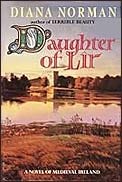Set in twelfth-century Ireland, Daughter of Lir sometimes teeters on the brink of over-romanticizing Irish traditions and feminist values, but a healthy dose of realism always pulls it back from the edge. The heroine is no pillar of feminist virtue but a woman full of flaws who grows and learns to accept that men, despite their perpetuation of a brutal system, are more than just the enemy.
In 1154, six-year-old Finola is left at a Norman convent. Spirited and intelligent, she wins the mother superior's heart with her understanding of horses and grows up determined to rise in the convent hierarchy. Her big chance comes in an unexpected, unwelcome form. As an over-confident eighteen-year-old, she is sent to Ireland as a result of King Henry II's political maneuverings, to become Abbess of Kildare. It is a lifetime position embellished with customs more pagan than Christian, inherited in a direct line from Saint Brigid herself. Carried "on a gilded throne" to a church "crazy with colour," she feels "swelled with the indecency of power."
Ruling over both nuns and monks, Finola delights in her new prominence until she realizes how vulnerable she is. When she interferes with King Dermot of Leinster's war plans, she learns the ultimate meaning of raw male power: he attacks the abbey and has her raped and removed from office. Devastated, emotionally damaged, she has a chance to rebuild her life, but must discard an entire belief system and accept a frightening level of risk. If she succeeds, she will have the tools to wield power again, more deftly and wisely, but certainly not in safety.
Daughter of Lir is less grim and more humorous than its subject matter suggests. Norman pokes gentle fun at her characters' medieval certainties and prejudices, part of the reason Finola holds a reader's sympathy despite attitudes typical of her time. Indeed, many characters are surprisingly sympathetic - except for the heartless Dermot, who eventually suffers an appropriately horrible fate. (1988; 379 pages)




